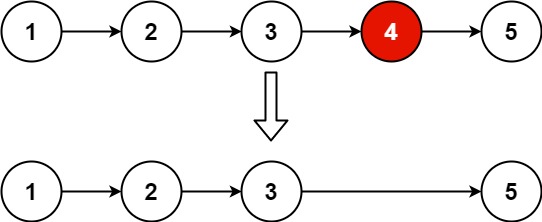19. Remove Nth Node From End of List
Medium
Description
Given the head of a linked list, remove the nth node from the end of the list and return its head.
Example 1:

Example 2:
Example 3:
Constraints:
The number of nodes in the list is sz.1 <= sz <= 300 <= Node.val <= 1001 <= n <= sz
Follow up: Could you do this in one pass?
Solutions
Approach: Fast and Slow pointers
Time complexity: \(O(n)\)
Space complexity: \(O(1)\)
Way 1:
Algorithm 1
We define two pointers fast and slow,both initially pointing to the dummy head node of the linked list.
Next, thefastpointer moves forward n steps first, thenfastand slow pointers move forward together until thefastpointer reaches the end of the linked list. At this point, the node pointed to by slow next is the predecessor of the n-th node from the end, and we can delete it.
The time complexity is 𝑂(𝑛) where 𝑛 is the length of the linked list. The space complexity is 𝑂(1).
class Solution:
def removeNthFromEnd(self, head: Optional[ListNode], n: int) -> Optional[ListNode]:
#Create a dummy node to handle edge cases
dummy = ListNode(0,head)
#Intialize pointer fast and slow
slow = fast = head
#Move fast pointer n nodes ahead
for _ in range(n):
fast = fast.next
#Move both pointers until fast reaches end
while fast.next:
slow = slow.next
fast = fast.next
#Remove the nth node from the end
slow.next = slow.next.next
return dummy.next
Approach: Simulation
Time complexity: \(O(n)\)
Space complexity: \(O(1)\)
Way 2:
Algorithm 2
class Solution:
def removeNthFromEnd(self, head: Optional[ListNode], n: int) -> Optional[ListNode]:
#Calculate length
tail , length = head, 0
while tail:
length+=1
tail = tail.next
#Use a dummy node to handle edge cases, such as removing the head of the list.
dummy = ListNode(0, head)
curr = dummy
#Find the node just before the one we want to remove
for _ in range(length-n):
curr = curr.next
#Remove the connection(nth node from the end)
if curr.next:
curr.next = curr.next.next
return dummy.next